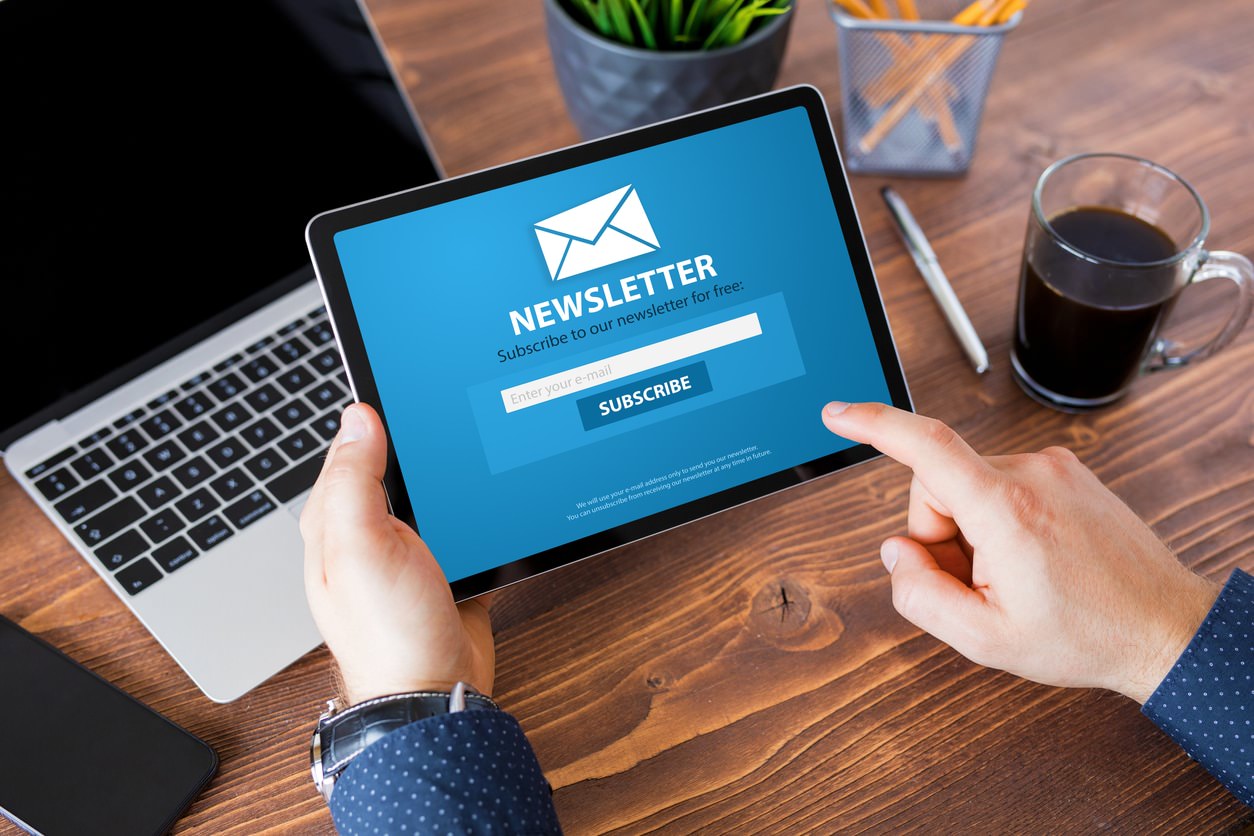Helpful Tips from Webolutions Digital Marketing Agency
Email Marketing Strategy
“Let’s put out a newsletter” It’s so simple, right?
Email marketing is a powerful tool for driving traffic, boosting sales, and building relationships with your customers. There are 4 billion daily email users, and over the last 12 months, 77% of marketers have seen continued increases in email engagement. In fact, more than 80% of small to mid-sized companies use email marketing to acquire and retain their business.
Despite its massive potential, and the fact that it is more relevant now than ever before, many businesses still struggle to make the most of their email marketing campaigns. This can stem from a range of issues, from a lack of understanding to the use of outdated strategies. Planning and executing consistently effective email marketing content can become a major source of frustration and squandered time.
Left unchecked, it can even permanently affect your email deliverability. Webolutions’ approach to email marketing strategy differs from other agencies. Our data-driven solutions have helped thousands of clients gain a competitive edge in their industry and enable them to grow and thrive. We work with our clients at every step of the process, from research and strategy to implementation and optimization.
In this article, we discuss four strategy mistakes that are quietly killing your email marketing efforts. By avoiding these common pitfalls and employing an experiential marketing strategy, you will ensure your email campaigns are successful and achieve their maximum potential.
1 – Quality Over Quantity – An Email Marketing Cautionary Tale
 If you have a distribution list of 10k contacts, but only 859 of those people ever open your email, you’ve actually only got a distribution list of 859 (with an additional 9k+ of unengaged dead weights that are progressively destroying your email deliverability). So while on paper, a larger list may seem more appealing, there’s no benefit in sending recurring email campaigns to stagnant contacts. This practice is most commonly referred to as sending graymail.
If you have a distribution list of 10k contacts, but only 859 of those people ever open your email, you’ve actually only got a distribution list of 859 (with an additional 9k+ of unengaged dead weights that are progressively destroying your email deliverability). So while on paper, a larger list may seem more appealing, there’s no benefit in sending recurring email campaigns to stagnant contacts. This practice is most commonly referred to as sending graymail.
Graymail can harm your email deliverability because it encourages contacts to unsubscribe and mark your emails as spam. Even lackluster enthusiasm amongst your audience can seriously damage your sending reputation. When marketing emails drive open rates lower than 15%, it sends a message to email service providers that your domain is sending spam, increasing the likelihood that all your future emails will be automatically moved to the recipient’s spam or junk folder.
This is by far the most common mistake being made, but also one of the easiest to correct:
- Avoid sending graymail and only send marketing messages to people who have previously expressed an interest in hearing from you. Ensure that you’re regularly removing unsubscribes and contacts with stagnant engagement. By simply eliminating the unengaged individuals from your distribution, you will immediately improve your email performance.
- Automate this by creating a Sunset Process for engagement and regularly purging the contacts that aren’t interacting with your emails. To do this:
- Create a filter in your CRM or campaign software that shows you:
- The last recorded open of any email you have sent is over 90 days ago
- Or, if the contact has opened 0 of the last 6 consecutive marketing emails you have sent them
If a contact falls into this filtered group, they can be considered ”Unengaged.”
- You can create a suppression list based on this filtered list, preventing them from being included in future emails from this campaign.
- This new list segment should then also trigger a strategic recapture campaign to re-engage with them one last time and confirm if they have a continued interest in receiving the subscription.
- If not, give the contact an opportunity to leave valuable feedback on why they lost interest.
- If they respond positively, they remain an active recipient of that distribution and their engagement status is restored. Those who remain uninterested or unengaged are removed from the campaign’s distribution list until they resubscribe.
Dropping unengaged contacts from marketing lists can seem like a precarious proposition to many marketers. But in the long run, when you’ve properly segmented your audience and focus primarily on engaged contacts, you will reap more actionable performance data and preserve the quality of user experience you want your audience to associate with your brand.
Read our article: 5 Email Marketing Problems
2 – Make Substance your Standard
 Consistency is crucial, but for recurring publications, be careful not to fade into the background by letting your publication become stale or repetitive. Providing fresh content is important because it keeps readers engaged and encourages them to continue reading. You want to generate that buzz and leave your audience anticipating the next distribution. Giving your audience something to look forward to not only makes them more likely to open and engage but strengthens your brand’s “authority” in readers’ minds over time.
Consistency is crucial, but for recurring publications, be careful not to fade into the background by letting your publication become stale or repetitive. Providing fresh content is important because it keeps readers engaged and encourages them to continue reading. You want to generate that buzz and leave your audience anticipating the next distribution. Giving your audience something to look forward to not only makes them more likely to open and engage but strengthens your brand’s “authority” in readers’ minds over time.
You can do this by ensuring your content is relevant and valuable. Guarantee to your audiences that by having subscribed to this publication, they are going to be receiving valuable insights and exclusive content.
Remain on theme but try a/b testing a variety of content types, find your sweet spot for ongoing structure, and cultivate the interests and engagement of your subscribers. Make a point to regularly review your campaign’s performance and structure, looking for trends and opportunities for optimization.
6 Examples of High-Performing Email Content
The following content types typically help generate interest in your newsletter:
Blogs – Blogs are a wonderful way to build a newsletter audience because they provide fresh content that readers can access on a regular basis. By having a blog, you can easily highlight new products, updates, and valuable content that encourages readers to subscribe to your newsletter. Additionally, blog posts can be easily shared on social media platforms, which can help to draw more attention to the content and encourage more people to subscribe to your newsletter. Make sure you have actionable CTAs on the blog post the email redirects to. Additional website visits are great, but conversions reign king.
Case studies – Case studies are another terrific way to show the impact of a product or service in a real-world situation. By showcasing success stories through case studies, newsletters can demonstrate the value of an offering to potential customers, as well as inspire current customers to consider additional ways to use the product or service. Case studies also provide a means for sharing innovative ideas, processes, and best practices, which can help readers become more successful in their own businesses.
Polls – Polls are a great way to engage your newsletter audience and get their feedback on important topics. They can give you valuable insights into your readers’ preferences, opinions, and thoughts, which can help inform your content creation and marketing strategies. Additionally, polls can be a fun and interactive way to keep your readers engaged and coming back for more.
Company culture or team spotlights — These features show your business’ authentic side and humanize your brand. New hires, anniversaries, achievements, and community outreach provide great sources of material to highlight your team members and their accomplishments. This the content writes itself and elicits trust and loyalty among your audience.
 Third-party content – Third-party content can be a powerful addition to newsletters because it can provide fresh, varied and labor-free content that is not just coming from the same source. The most immediate added benefits to using this kind of content can include:
Third-party content – Third-party content can be a powerful addition to newsletters because it can provide fresh, varied and labor-free content that is not just coming from the same source. The most immediate added benefits to using this kind of content can include:
- Increased Reach: Using third-party content in marketing newsletters provides the opportunity to reach a much wider audience than your own content can. This is beneficial because it allows your message to be seen by people who may not have otherwise come across it.
- When you publish your recurring publications, like newsletters, make sure to publish it on LinkedIn as well. Now that third-party content can be tagged, and your organic lead-gen posts are seen by all the audiences following those sources. You compound your reach and potentially your organic conversion rates as well.
- Don’t dual-publish? Although not dual publishing is a missed opportunity, you can still post an organic preview of your newsletter as a post. Link a redirect for audiences to subscribe, and in the post itself you can tag those third-party sources if you include a snippet from that added content in your post.
- Establish Authority: Including third-party content in newsletters can help establish your brand as an authority in the industry. By sharing content from other sources, you are demonstrating your expertise and knowledge.
- More Engagement: When people see content that they find interesting, they are more likely to engage with it. This can lead to more clicks, shares, and conversions.
- Increased Traffic: Sharing third-party content can also lead to increased traffic to your website. This is especially true if you link to the content in the newsletter and people click through to read the full article.
- Remember, if you are dual publishing as part of your LinkedIn organic lead-gen strategy, tagging third party content extends the reach of that publication, which potentially increases the conversions, and traffic from link engagement.
- Cost-Effective: Using third-party content in newsletters is a cost-effective way to reach a larger audience. It’s also much less time consuming than creating your own content.
Trending industry news – Including trending industry content in a newsletter is beneficial because it allows your readers to stay up to date on the latest developments within their industry. This ensures that your readers are always informed and engaged in their industry, and it also provides them with valuable information that they can use to make informed decisions. This will also attract new readers to your newsletter, as they will be drawn to the timely and relevant content.
3 – Failure to Track and Adapt
Standard KPIs like open rates and click-through rates are well-known critical data points for any email campaign. The benefit of recurring distributions like newsletters is that you are able to extract profile data points you can use to optimize your campaign’s performance and conversions.

A/B Test Your Headlines – 35% of email recipients open an email based on its subject line alone. Your subject lines should always be clear and concise. Shooting for a max character limit of 60, try to evoke an emotional response with action words, questions, or merge field personalization.
The following are examples of effective email subject techniques:
- Ask a question: “Is Your Marketing Strategy Missing Something?” Questions presented in a subject line will pique the curiosity of a reader. People are inherently pre-disposed to seek resolution when presented with a query.
- Create a sense of urgency: “Expiring Soon Act Now!” If the content is time-sensitive, like an approaching event or a limited offer expiring soon, include that information in the subject line. Create a sense of urgency and encourage your subscribers to take action before they miss out. The fear of missing out is a powerful emotion, and by leveraging that instinct you can increase your open rates and boost conversions.
- Use personalization: “Carlo, did you know?” Subscribers are 26% more likely to open emails with personalized subject lines. When you take the “perceived” time to personalize content, messages, and subject lines to the recipient, it makes them feel known and seen. Merge data and past engagement can help you easily personalize mass distributions, tailored to the recipient.
- Refresh Underperforming Content Types — Over time, you will begin to see which content and topics are more effective in your campaigns. Use this information during regular reviews to leverage more effective content and conversion drivers in future newsletters.
4 – Missed Opportunities and Tactical CTAs
 The best CTAs encourage engagement and generate urgency but remember that not every paragraph needs a sales pitch. Create a balance in your campaigns. For instance, newsletters should be roughly 90% informative and 10% promotional. This is where “direct” and “indirect” calls to action come into play:
The best CTAs encourage engagement and generate urgency but remember that not every paragraph needs a sales pitch. Create a balance in your campaigns. For instance, newsletters should be roughly 90% informative and 10% promotional. This is where “direct” and “indirect” calls to action come into play:
- An indirect, or transitional, CTA is designed to build trust with potential customers by offering a lower-risk option that eases them into doing business with you. Lead magnets work especially well on these. An effective indirect call to action will help draw in potential customers, deepen your business’s relationship with them, and encourage customer loyalty.
- A direct call to action is a phrase or sentence that encourages the reader to take immediate action. Examples of direct CTA’s would include “Sign Up Now!” or “Get A Quote.”
In either case, a call to action should never just go on and on. Ideally, restrict CTA copy to 2-5 words, and always make sure to emphasize the value proposition.
There are several diverse ways to structure your CTAs:
- Include a benefit: Why should the reader take action? Be clear about what they get out of clicking your link. Examples might include “Save time with our free download” or “Discover new ways to succeed.”
- Add urgency: Urgency can help motivate users to take action. Use phrases like “limited-time offer” or “last chance” to create a sense of urgency.
- Add a sense of exclusivity: Let the user know that your offer is exclusive and that they should act now to get it. Use phrases like “exclusive access” or “be the first to know.”
Increase Lead Generation and Improve Your Marketing ROI with Email Marketing
When done correctly, email marketing can be the basis of your digital marketing strategy. To maximize the impact of your campaigns, it is necessary to build and maintain a quality email list and create content that resonates with your audience. This includes using captivating subject lines, clear and concise messages, and optimizing your conversions through data analysis.
Remember to regularly evaluate your strategy and make data-driven modifications to create emails that drive traffic and increase your sales. Avoiding the four mistakes outlined in this article is a great starting point for creating a successful email marketing campaign. By employing an experiential marketing strategy and getting help from an experienced agency like Webolutions, you can ensure that your email campaigns will maximize their potential and help you reach your business goals.
Webolutions Can Elevate the Success of Your Email Marketing Campaigns
Crafting effective email marketing campaigns is part art and part science. When your efforts utilize industry best practices and leverage data to continually refine your campaigns, you’re much more likely to achieve your desired results. This level of performance typically requires assistance from an expert who understands the nuances of email marketing. At Webolutions, we have you covered.
Webolutions has been Denver’s leading digital marketing agency since 1994. During this time, we’ve provided our clients with the comprehensive marketing services they need to grow their business. Our email marketing strategies reflect years of testing to ensure we’re able to maximize the ROI on your efforts.
You’ll also benefit from our transformational Intrinsic Multiplier™ Approach, which is focused on growing your business faster, smarter and easier. Our unique approach to marketing involves a collaborative journey where we work with your team to identify what is special about your company. This allows us to determine your industry leading market positioning, allowing you to stand apart from your competitors.
Based on your market positioning, we’ll craft an email marketing strategy that provides an irresistible customer journey that will engage your audience at every stage of the funnel, helping you nurture your most qualified prospects until they become leads. Every campaign is data driven, allowing us to make adjustments as needed to improve your results over time.
Contact us today to find out how we can help improve your ROI on your email marketing efforts. Webolutions serves clients nationwide from our offices in Denver, Colorado.
- 4 Mistakes Quietly Killing your Email Marketing Performance - February 24, 2023



